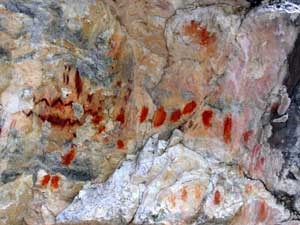
Alana Dimmick Upper Pictograph Cave is a window to the past. Painted on its walls are pictographs -- a type of rock art -- depicting people, animals, and abstract images. What is this art? Who painted these pictures and what do they mean? The ArtistsThe pictographs at Upper Pictograph Cave are believed to have been painted by the Fremont Indians, a farming and hunting group that lived in the Snake Valley from about 1000 to 1300 B.C.E. The Fremont built several villages, including one near present-day Baker, Nevada, called Baker Village. What little is known about this culture is based off of what we've learned from the artifacts and rock art found in their villages and throughout the region. The ProcessThe Fremont created rock art images by cutting into rock surfaces - which creates what we call "petroglyphs" - and by painting images, usually onto rock, creating what we call "pictographs". Rock was probably chosen as a medium because of its durability, and because of the protection rock shelters provide from the weather. The paint the Fremont used had to be durable. Like paint made today, it had three main ingredients that made it long-lasting. First, a pigment, usually inorganic, gave the paint color. One common pigment was the mineral hematite, which creates a red color. Next, a binder was added to hold the pigment particles together and to hold the paint onto the rock surface. Some examples of binder ingredients include blood, egg, seed oils, plants resins and juices, milk, and honey. The third ingredient of the paint was a medium, or a fluid, that made the paint liquid and suitable for application. Examples include plant juices, water, animal oils, and urine. The SubjectSome of the shapes and patterns that are represented on these cliff faces have been named by people who study rock art. Figures resembling human form are called "anthropomorphs". More specifically, the figures shaped like trapezoids are called "Fremont-style anthropomorphs". Figures resembling animal forms are called "zoomorphs". While many of the pictographs clearly represent living things, some of the art is more abstract - dots and lines drawn on the rock surface with paint or charcoal. What do these pictographs mean? No one can say for sure what the painter had in mind when creating these images. We could guess, but that might lead to wrong conclusions about the images and the people who made them. We are left, then, to wonder. Any meaning we give these paintings is merely speculation, and what they actually represent - if they do, in fact, represent anything - may never be known. More Than PicturesBesides the rock art, artifacts have been found in this cave. During the 1930s, E.P. Harrington recovered stone artifacts, animal bones, ashes, charcoal, and fire-cracked rocks buried in the floor sediment. These artifacts show that the cave was used for more than just a place to paint figures. Upper Pictograph Cave has been used by animals as well as people. Packrats used this shelter to build their nests - or "middens" - and Townsend's big-eared bats have been known to use this cave from time to time. These bats are very sensitive to the slightest disruption, so it is essential to not go inside. Instead, enjoy this cave and its special features from the outside, and leave with a better understanding and appreciation of this natural and cultural resource. Threats to the CaveOver the years, vandals have written over and destroyed some of the art in Pictograph Cave. It is important to understand that the images painted on the rock wall are delicate and we must carefully protect them. These images are one of the few links we have to the people who came here before us. Please do not touch any of the pictographs, or engage in any activity that might damage them. |
Last updated: April 22, 2025
